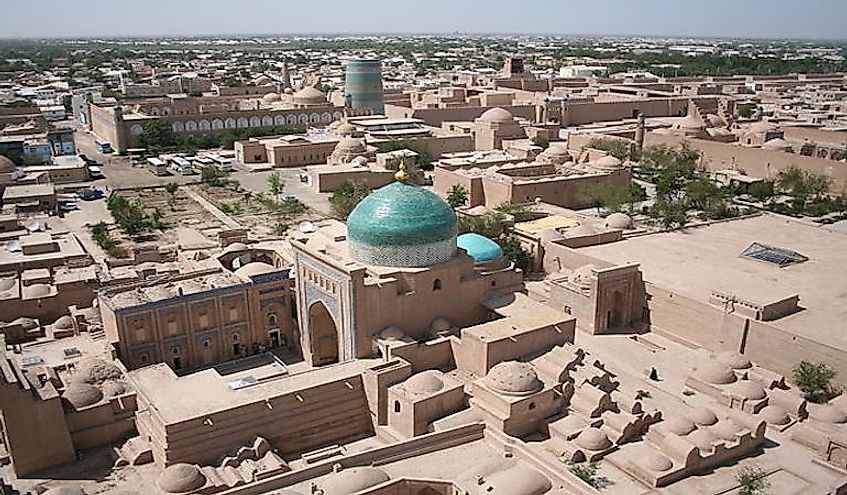UNESCO World Heritage Sites In Uzbekistan

Uzbekistan was an important trade centre on the ancient Silk Route. The region grew to prominence under different dynasties and civilisations. Uzbekistan has medieval monuments strewn all over the country that attests to its medieval significance. Cultural tourism is the primary tourism in Uzbekistan. The country has been cashing in on its religious and cultural heritage. Uzbekistan is home to one natural and four cultural World Heritage Sites, one of which is endangered. These heritage sites include:
Itchan Kala
Itchan Kala was the first World Heritage Site inscribed in 1990. Itchan Kala is a walled city in Khiva and is the largest surviving wall city in the Central part of Asia. The City was traditionally known as Khorezm and was an important stop on the Silk Road. Its significance made it subject to different occupations. It was under the Timurid Empire that many of Khiva’s cities rose to prosperity. The city’s rulers, the Khans of Khiva, built the wall to keep off colonial threats. Itchan Kala was preserved by Russian colonial rulerd and is a cultural heritage in modern day Uzbekistan.
The city and the wall have been preserved as the State Historical Archaeological Museum. There are nearly 60 historic buildings preserved in the city including palaces, mosques, minarets and pillars. Itchan Kala and the greater city of Khiva is one of the most important tourism centres in the nation.
Historic Center Of Bukhara
Bukhara is a city museum in Uzbekistan and was inscribed as a UNESCO World Heritage Site in 1993. The city can be traced back to as early as the 6th century BC, rising to prominence to become a major trade and cultural centre on the Silk Road. The city was a Muslim centre, and there are numerous mosques and madrassas in the city that attest to its religious significance. There are nearly 150 historical monuments preserved in the city in a modern day Uzbekistan. Monuments include mosques, madrassas, mausoleums, and minarets. The city has increasingly become a tourist destination and has influenced the proliferation of bazaars, restaurants and hotel facilities in the city.
Historic Center of Shakhrisyabz
The Historic Center of Shakhrisyabz was listed by UNESCO as World Heritage Site in 2000. The monuments in the city were built during the Timurid Empire. The town was the birthplace of Amir Timur, who was a great leader of the Timurid Empire. He built the town in grandeur and elegant architecture and made it the second capital of his extensive empire. The town is home to the renowned Ak-Saray Palace, which was built as a massive and stylish complex of public and residential buildings. The decorations of the palace have been preserved although partly ruined over time.
Other monuments in the town include mausoleums, market centre, bathhouses, tombs, and mosques. The site has been included on the endangered list, because of over-development of tourist facilities in the area.
Samarkand
Samarkand has been on the list of UNESCO World Heritage Site since 2001. It thrived as an ancient city, and it is still important in modern Uzbekistan. The city was established in the 7th century and prospered under the Timurid dynasty. Samarkand was at the forefront of Islamic architecture, and its significance is witnessed in the old town. There are numerous mosques, madrassas and residential houses, lined on narrow streets and built in medieval Islamic fashion. The western part of the city is more modern, with architecture reflecting 19th and 20th European design and style, influenced through Russian colonisation. The city has often referred as a crossroad of cultures. Samarkand was also an important trade stop along the Silk Road.
Samarkand today is the third largest city in Uzbekistan. Monuments in the city such as mosques, madrassas, and mausoleums have been preserved and are major tourist attractions in the cauntry.
Western Tien-Shan Mountains
The newest addition to the list, the Western Tien-Shan Mountains was inscribed as a natural UNESCO World Heritage Site in 2016. The Tien-Shan ranges extend to different countries in Central Asia. The mountain range in Uzbekistan covers a total of 96,000 km2, nearly 21% of the nation’s territory. Around the mountains are numerous resorts, which offer tourist services such as skiing, rock climbing, sky surfing and sightseeing. The region has several archaeological and historical monuments as well. There are different reserves to protect the mountain’s wildlife such as the snow leopard, Tien Shan brown bear, and the wolf.
Uzbekistan, as a tourist destination, has not been as accessible as other top world destinations. This situation has caused the country to have a large untapped tourism potential. Efforts to boost tourism in the country have resulted in a surge in the number of tourists visiting the country. Prospects place Uzbekistan as an emerging tourist destination in the region of Central Asia.
UNESCO World Heritage Sites In Uzbekistan
| UNESCO World Heritage Sites in Uzbekistan | Year of Inscription |
|---|---|
| Itchan Kala | 1990 |
| Historic Center of Bukhara | 1993 |
| Historic Center of Shakhrisyabz | 2000 |
| Samarkand | 2001 |
| Western Tien-Shan Mountains | 2016 |







